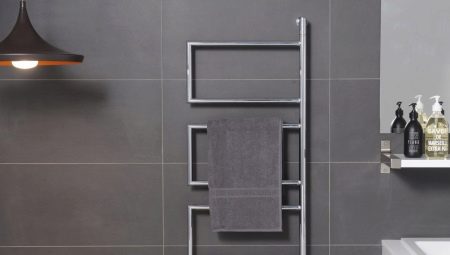Today, heated towel rails are an indispensable unit of any bathroom. They allow not only quick and effective drying of raw linen, but also stabilize the humidity in the room, and also raise the temperature in the bathroom. In this article you will find out what types of towel warmers are, and also get acquainted with the features of their choice.
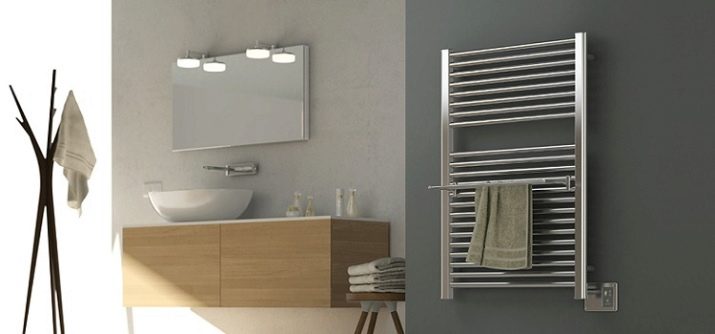
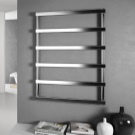

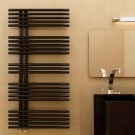

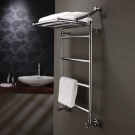
Features
A heated towel rail is a pipe radiator that can run on water or electricity. Unlike classic radiators and radiators, the main task of heated towel rails is not in increasing the temperature in the room, but in drying the bathroom accessories and linen, which is hung directly on the pipes of the unit.
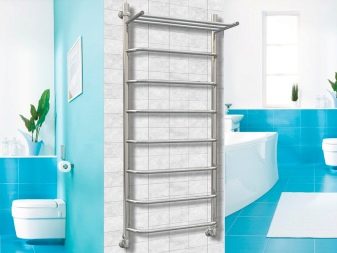
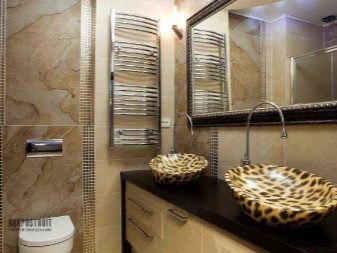
Device and principle of operation
The principle of operation of heated towel rails varies depending on its variety. If this is a water-based model, the heating of the pipe components is carried out by passing hot water through the unit, which is supplied directly from the central heating system. If we are talking about electric models, then using a tubular electric heater, either the oil that circulates in the pipes or the surface of the pipes itself is heated.
Water models of heated towel rails are directly dependent on the heating system, electric ones work from the network through insulated cables.

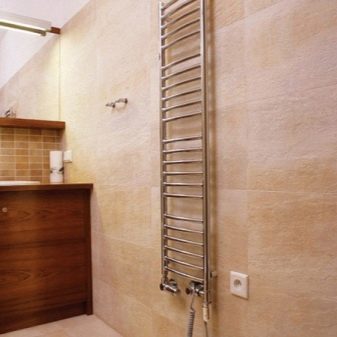
Working principle is in the supply of heat from the heater or hot water to the surface of the unit. Towels hung on the tubes of the appliance heat up and evaporate moisture, thereby drying out. The humidity that is generated during this process also evaporates.
Depending on the device and the principle of operation, heated towel rails can be mounted on the walls of the bathroom, on the door or installed inside showers.
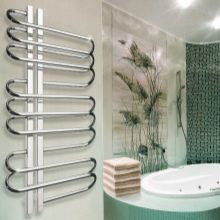
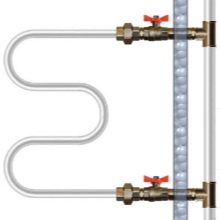
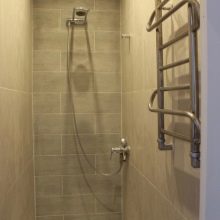
Advantages and disadvantages
Most models of modern heated towel rails do not have any common drawbacks, however, they have an impressive number of advantages, thanks to which such units are today considered indispensable for any bathroom.
Pros.
- fast and efficient drying wet things;
- additional heating a bathroom;
- maintaining optimal humidity, removal of condensate from the walls of the bathroom, protection of the room from mold;
- style addition and the interior of the bathroom;
- unit optimization for human needs - Many modern dryers have hooks, towel racks and shelves for bath accessories.
If we talk about the disadvantages of heated towel rails, they usually relate to certain models on the market or units made of certain materials.
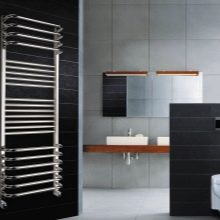

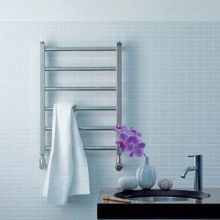
Which are there?
Experts prefer to divide all heated towel rails into two categories: according to the principle of operation and type of installation. Regarding the principle of operation, all these devices are divided into water, electric and combined. If we talk about the features of their installation, then heated towel rails are divided into wall, floor, folding and portable. Below will be considered the features of operation of each variety.
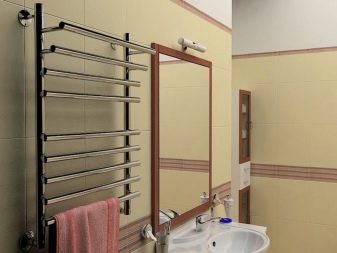
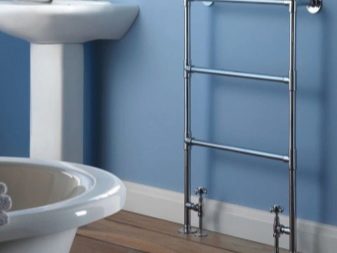
Water
Towel dryers of this type are usually called coils - pipe radiators, which were installed in old houses of the house back in Soviet times. The principle of operation of such devices has not changed much to date, however their design and overall performance has changed significantly.
Such towel warmers directly connected to the heating system, regardless of whether it is centralized or individual. Alternatively, if the coil is installed after major repairs of the room, it is allowed to install the coil in a common line with a heated water floor.
An obvious plus of such devices is that they are completely independent of power supply and do not spend extra energy. The disadvantage of such units is in their dependence on the heating system in the house. So, in the absence of hot water, coils of this type will be absolutely useless.
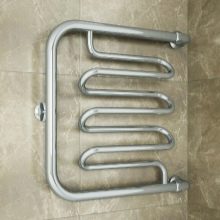
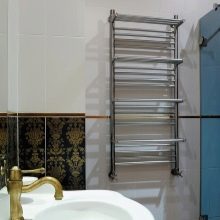
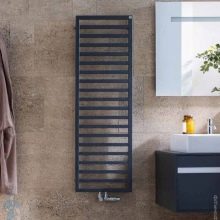
If we consider the key pros and cons of water heated towel rails, we can distinguish the following.
Pros.
- Full independence from energy supply.
- High power and the ability to effectively dry towels and heat the room.
- Relatively simple construction which cannot break.
- No complicated installation required and further care / maintenance.
- In terms of operation, water dryers absolutely safe - the surface temperature of such devices is not high enough to cause a burn.
- When compared with other dryers, water models are considered the cheapest in terms of the cost of installation and further maintenance.
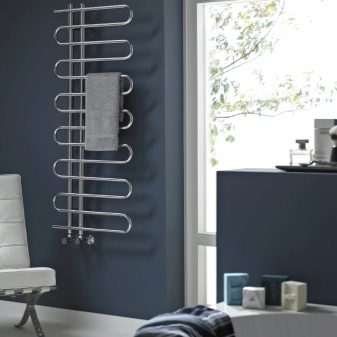
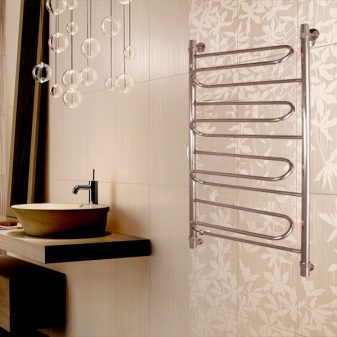
Minuses.
- Dependence on heating system and water supply.
- After a long time of operation or in case of problems in the supply of hot water air clogging in such dryers is possible.
- If externally such designs remain unchanged for decades, then inside over time they may scale or corrode.
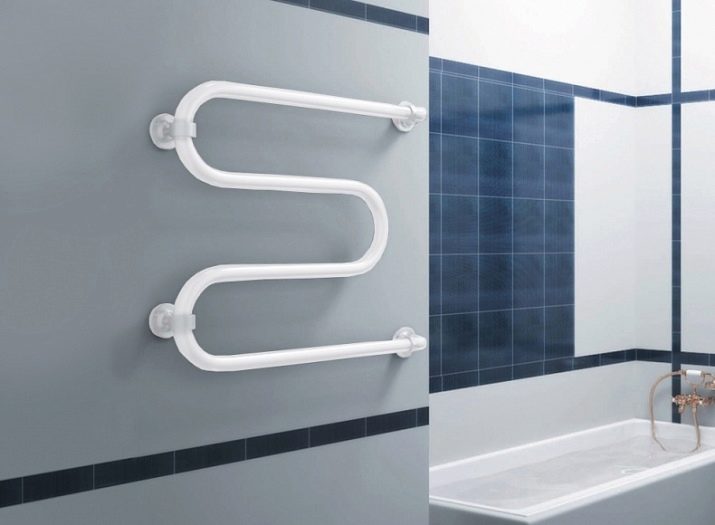
Electric
Towel dryers of this type are complete batteries with a closed loop. Typically, such dryers are larger than water models, due to the need to place a tubular electric heater (or heater) in them.
The main feature and advantage of such dryers is the ability to install these units at absolutely any point in the apartment where there is access to a power outlet.
Electric heated towel rails can also be divided into oily and dry. Oil-type units operate on oil-based fluid, which is heated by the operation of an electric heater. In the “dry” models there is no oil - only the cable is used for heating.
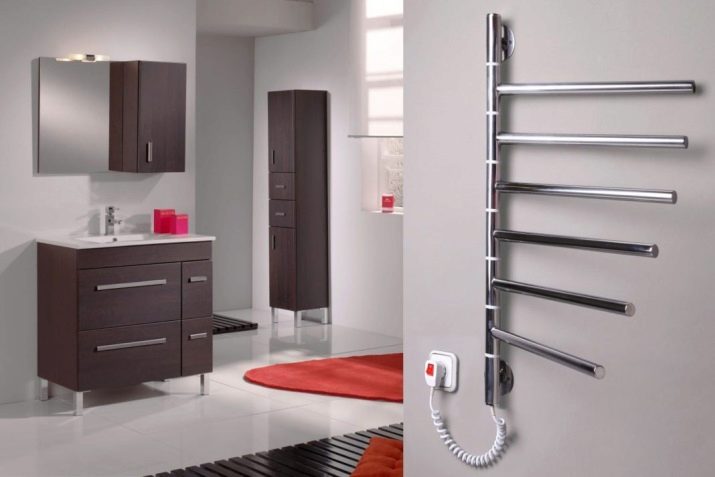
Such devices also have their positive and negative sides.
Pros.
- Electric models, like water models, are different long service life and reliability.
- Electric Shock Models independent of the heating system. They can be used absolutely at any time with a stable supply of electricity.
- In such designs it is possible to change the power settings. Such models provide high-quality drying at a relatively low cost of electricity.
- Unlike water models, which are completely dependent on the heating system, electrical can be suspended at any time.
- Many modern electric heated towel rails have a number of additional featureswhich help to use the device even more comfortably. The most common of them - thermostat, timers, shutdown system when overheating.
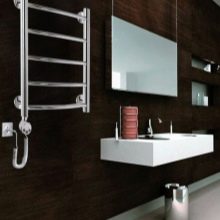
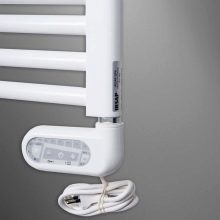
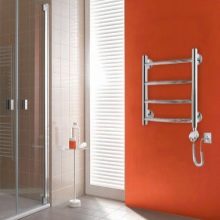
Minuses:
- such units completely dependent on energy supply and will not work effectively in regions with regular power outages;
- electric dryers require additional and complex installation and connections to the central network;
- usually electric models are much more expensive than water.
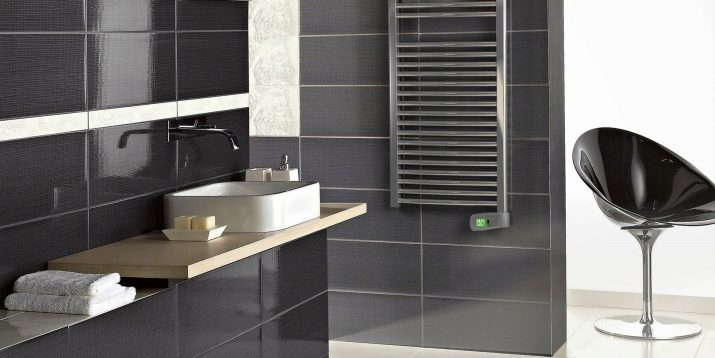
Combined
Today, combined heated towel rails are considered the best option for drying bath accessories. These devices can work both from the heating system and powered by the mains. That is, their design includes both fittings and a full cord for connecting to an outlet.
The main plus of such designs is obvious - they can be used all year, regardless of the operation of central heating or interruptions in the network. This versatility of the device also creates a significant drawback - for the full operation of such devices, it is necessary to carefully select a place for their installation, where there would be access to a power outlet and to the heating system.
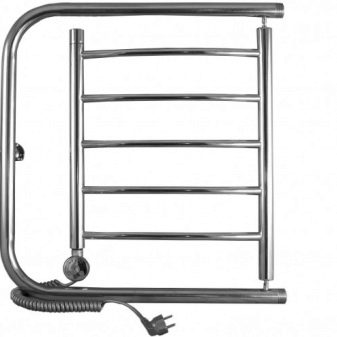

Additional advantages and disadvantages of such units.
Pros:
- universality - can work from two sources of energy;
- regarding simple operation and maintenance;
- thanks to the combined principle of operation are the most economical of all dryers;
- may also possess A large number of additional features.
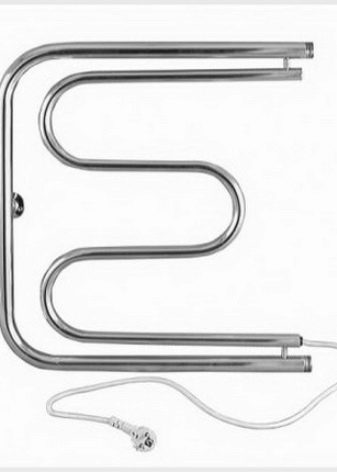
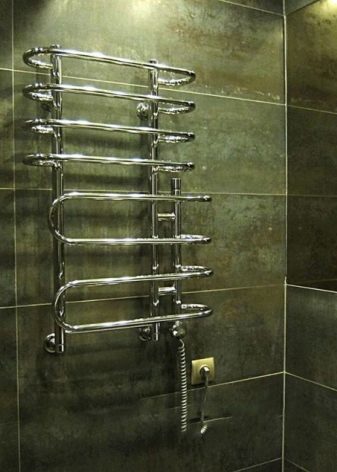
Minuses:
- need in a more thoughtful installation;
- quality combined models are more expensive than electric;
- in case of internal breakdown need qualified repair.
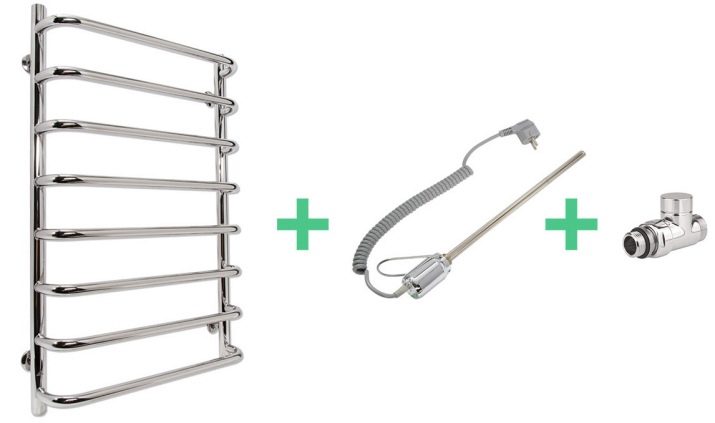
The classification of heated towel rails relative to the installation option is not so common, however, also used by specialists.
- Wall mounted. Such options for heated towel rails are considered the most common. Their design allows you to effectively save space in a small bathroom.
- Floor standing. They are larger-sized dryers that are installed in large bathrooms and often serve to zonate the bathroom.
- Folding. This type is an independent version of wall mounted towel rails. Such units can partially change their position, rotate or spin around their axis. An obvious minus of such models is the gradual wear of the elements in the places of bending.
- Portable. These are exclusively small electric heated towel rails that can be successfully used in any room, and not just in the bathroom.
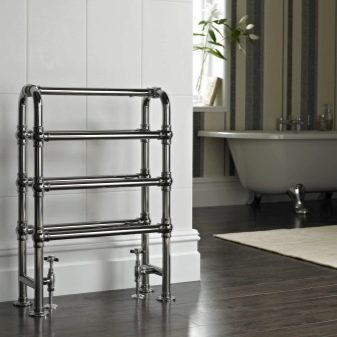
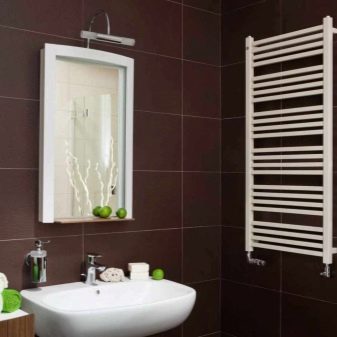
Shapes and sizes
All heated towel rails can also be divided into shapes and sizes.Dryers of the standard type are heating elements in the form of the letter "P" or "U", but there are also less common forms.
Recently, more and more popular models of heated towel rails namely of creative forms.
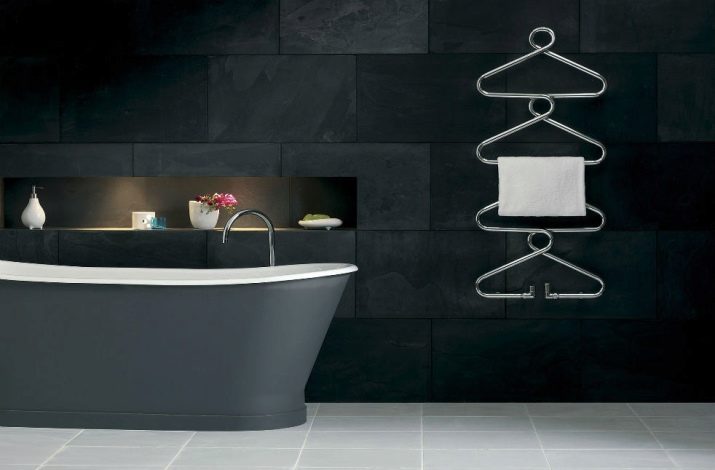
Among the most popular forms of bathroom dryers are the following.
- Coil, zigzag or M-shaped - standard battery in the form of an elongated letter "Z" or an inverted letter "M".
- "Ladder" - represents two vertical pipes connected by several pipes of a smaller diameter parallel to each other. An extremely effective option for simultaneously drying a large number of small items or linen.
- U-shaped or U-shaped (depending on the position relative to the wall). They are two horizontal pipes parallel to each other, perpendicularly connected by one vertical pipe. In appearance, such units resemble the inverted letters "P" or "U".
- Double-circuit - a less common form of heated towel rails, where there are duplicate segments of the water supply, one of which is connected to heating, and the other to the hot water supply pipe.
Do not, of course, forget about the extraordinary forms of heated towel rails - usually these are water models made of copper, aluminum or brass in the most extraordinary and intricate positions and shapes.

If we talk about the size of the heated towel rail for the bathroom, then they are selected individually for the dimensions of the room or niche on which the unit will be mounted. Large towel dryers are usually chosen by large families, where a large number of items are required to be dried immediately.
It makes sense to focus on the dimensions of the bathroom itself when choosing heated towel rails.
- For bathrooms with area up to 6 square meters units with sizes of 50x40, 50x50 and 50x60 cm are best suited.
- To the room up to 8 square meters models 60x40, 60x50 and 60x60 cm will fit well.
- If you have a bath up to 11 squares, then units with sizes of 80x40, 80x50 and 80x60 cm should come here.
- For bathrooms with an area 11 to 14 square meters and it’s more reasonable to select large and overall models with sizes of 120x40, 120x50 120x60 or 120x80 centimeters.
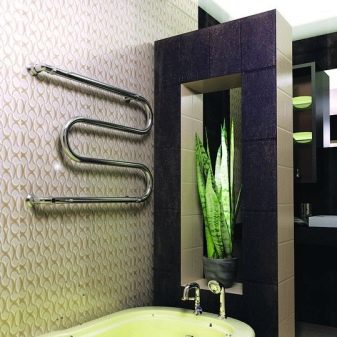

Materials
The heated towel rail material affects the heating efficiency, the durability of the device, as well as the safety of its use. In addition, each material from which the dryers are made will look different in a different stylistic solution. Usually, heated towel rails are made of compacted steel, stainless steel or non-ferrous metals such as brass, copper or aluminum.
In order for the unit to remain attractive and reliable for a long time, a coating is applied to it, which can be chrome-plated, painted or polished.
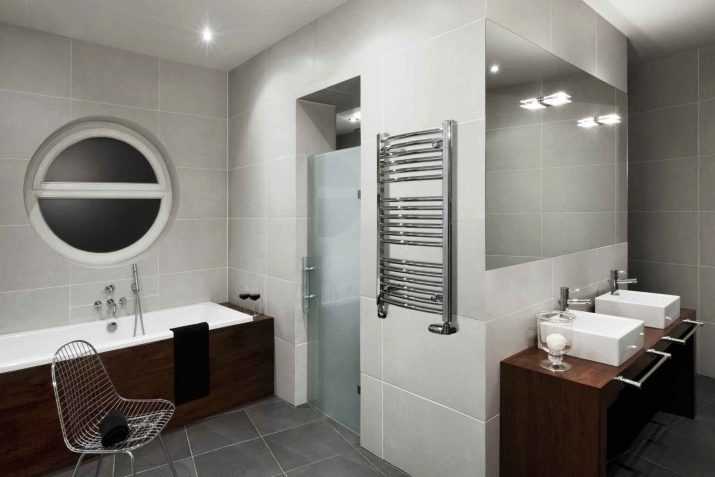
Steel
Steel is an alloy of carbon and iron with the addition of some additional elements. The main properties of steel can be considered excellent thermal conductivity, high strength, a sufficiently large weight, but susceptibility to corrosion. So that such units can serve for a long time, they are applied a special anti-corrosion coating.
Steel is today considered the most common option in the manufacture of towel warmers: such units are inexpensive, but have a relatively short life in conditions of constantly high humidity.
Steel dryers are recommended It is in private homes with individual heating systems. The fact is that water-based steel elements eventually become coated inside with layers of salts and water impurities, which lead to blockages. Such blockages can cause gaskets to leak and even flood the bathroom.
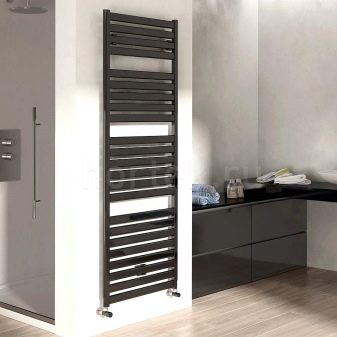
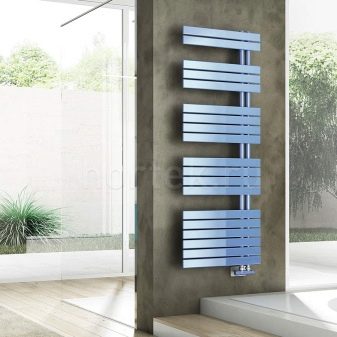
Stainless steel
Stainless steel towel dryers are more durable and reliable than steel units - most often they are installed with the expectation of a long service life. The main advantage of stainless steel devices is resistance to corrosion, as well as the ability to withstand high pressure. As in the case of steel appliances, stainless steel units conduct heat very well.
If we talk about the cons of stainless steel, then the most important thing here is the high price for quality models. In addition, the modern market presents a huge number of low-quality heated towel rails from stainless steel, and it can be difficult for an inexperienced owner to distinguish between these two materials.
Stainless steel heated towel rails can withstand corrosion for much longer than steel appliances. Besides, they usually have an additional coating (chrome, paintwork).
The most durable and reliable are considered to be the chrome-plated stainless steel heated towel rails.
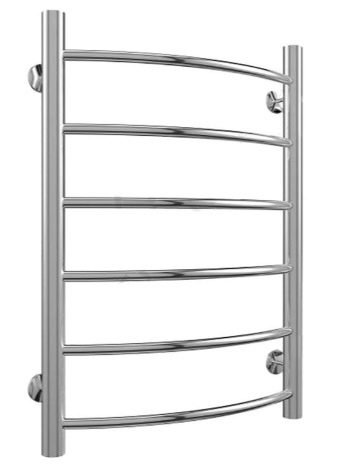
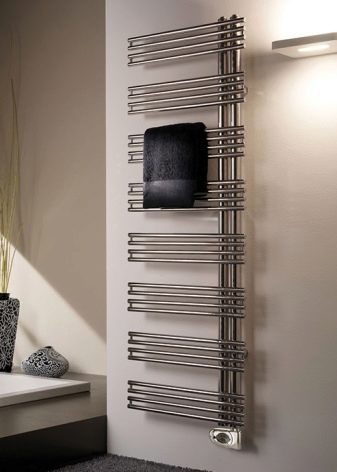
Non-ferrous metals
Some experts consider these materials universal in the design of modern bathrooms. Copper and brass heated towel rails have a beautiful and stylish appearance and color, which allows the use of such materials in the most unusual style solution. Besides, it is from brass and copper that dryers of the most original forms are usually made, since these materials are characterized by increased ductility.
Another advantage of brass and copper products can be considered corrosion resistance. If we talk about their disadvantages, non-ferrous metals due to their ductility are able to withstand relatively low pressure (usually up to 4-5 atmospheres). In addition, they usually cost much more than steel options.
Typically, colored materials are used in the creation of radiators and heated towel rails in bathrooms with a certain style solution, where a standard steel coil will look out of place.
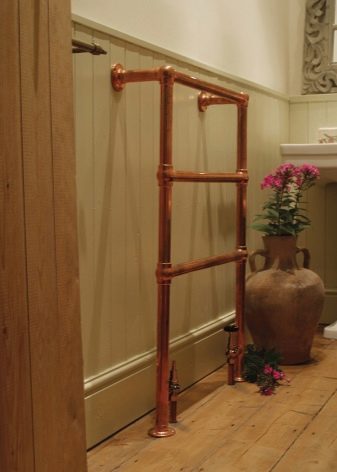
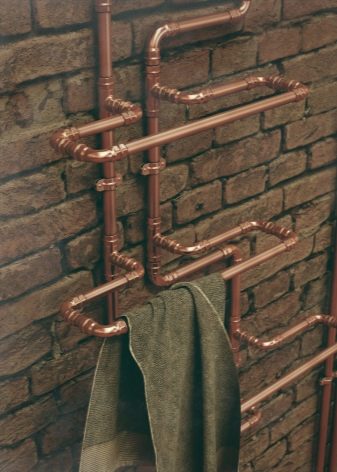
Chrome or polished coating is a prerequisite for the purchase of such models. It will not only increase the life of the device, but also preserve its appearance.
Aluminum is a fairly light, cheap and durable material that has good thermal conductivity. Aluminum, like other non-ferrous metals, is unable to withstand high pressure, and therefore it is rarely used to create bath dryers.
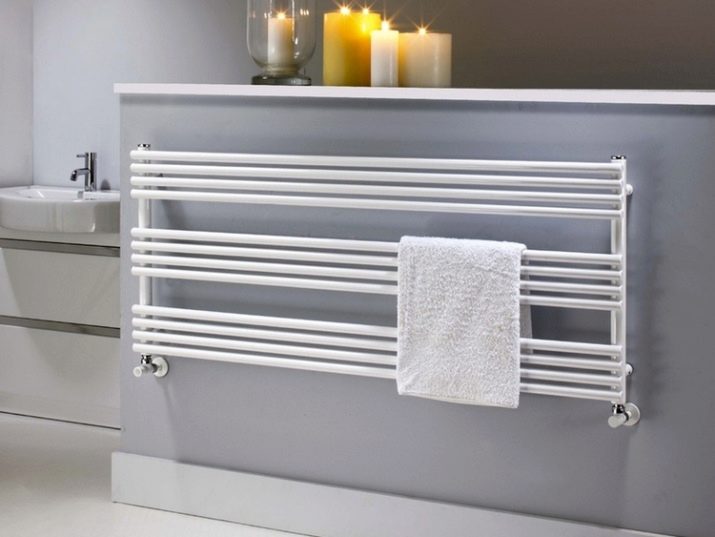
Plastic
The easiest, cheapest, but far from the most reliable material in creating towel warmers is plastic. Most often, such models are covered with a special film “chrome”, which improves the appearance of the device and suggests the idea of the strength of the material. Some manufacturers very skillfully adjust these models to products made of chrome, but they can easily be distinguished from plastic in light weight.
Most experts agree that plastic is the most inappropriate material for creating dryers. For plastic, regular breakouts, the formation of chips and cracks, as well as breaks from the thread, are common.
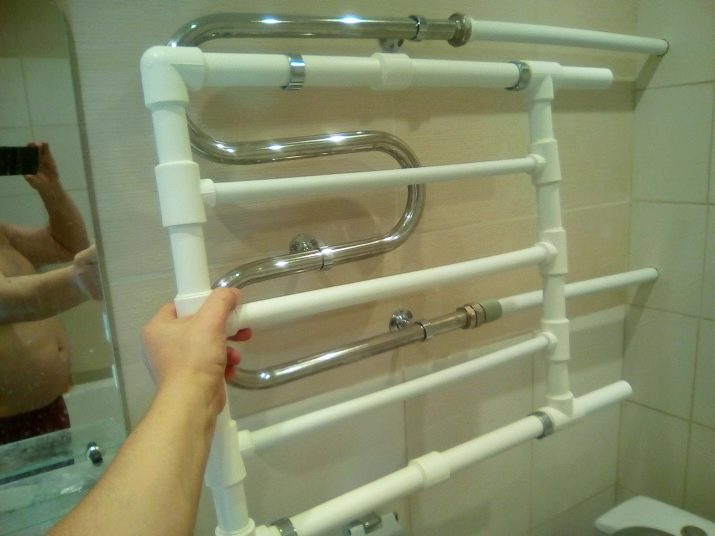
Design options
It is worth saying a few words about the features of using heated towel rails in different style and design solutions.
- Classic. The classic style is considered one of the richest in the design of bathrooms. Golden or silver aggregates of standard U-shape or “ladder” will fit here best.
When choosing units for such bathrooms, the general color scheme of the room must be taken into account.
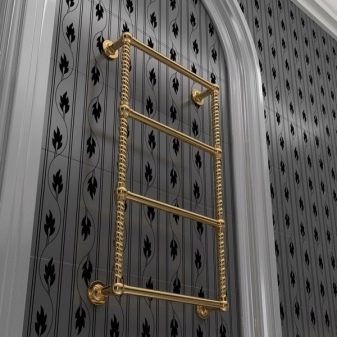
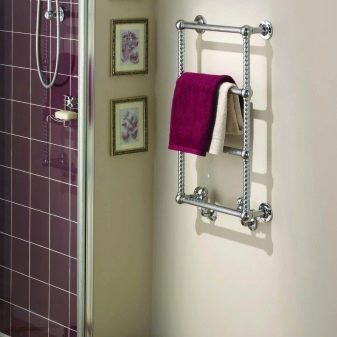
- Minimalism. The key characteristics of this style can be considered simplicity and practicality, and therefore creative and original heating elements of unusual shapes and sizes are not suitable here. Best of all, towel ladders in the classic silver color with a chrome finish will look here.
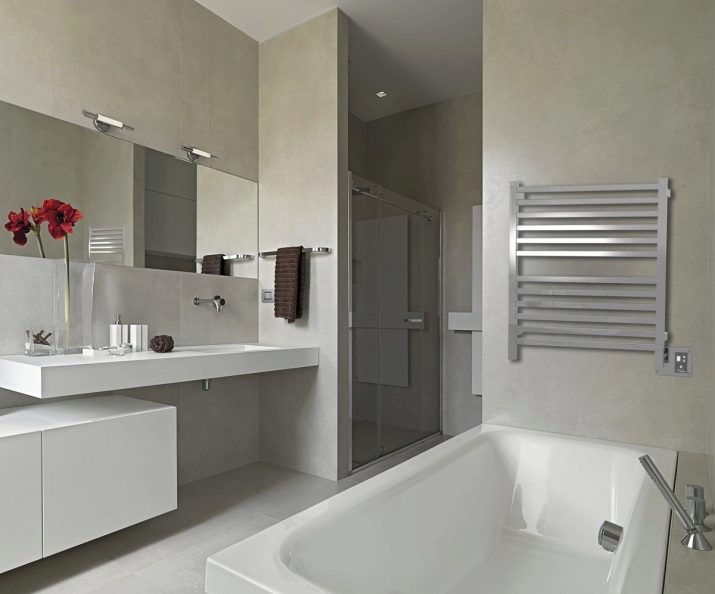
- Country and Provence. For this style, units of absolutely all shapes, but small sizes, preferably with additional wooden elements, are suitable. Also, brass or copper dryers will fit in well here - they will harmonize with the warm color background of the room.
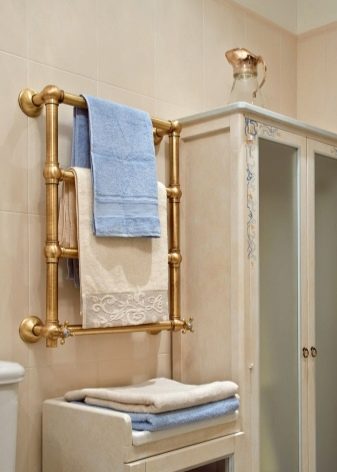
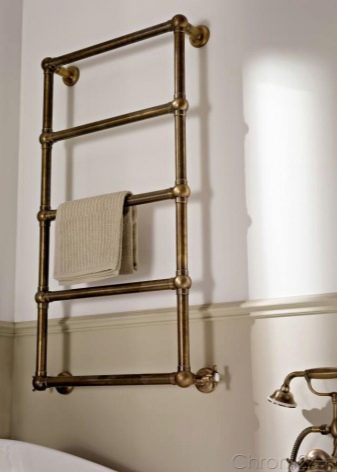
- Retro. In retro style, which is based on old-fashioned motifs, heated towel rails with bronze or brass finish will perfectly fit. Regarding the shapes, you can also experiment here - models with fancyly curved handles that imitate the ancient styles of bathrooms can fit in well here.
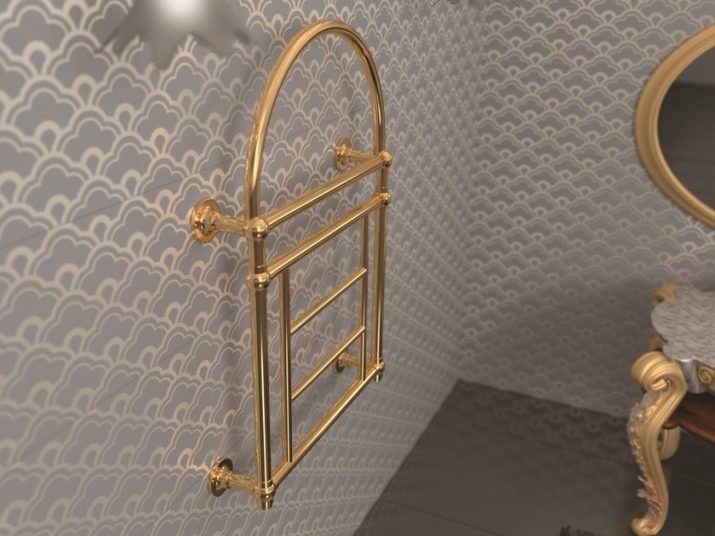
- Eco. This includes all models of heated towel rails in pastel and white colors and discreet forms.
Such units only complement the interior of the room, but will never stand out against its background.
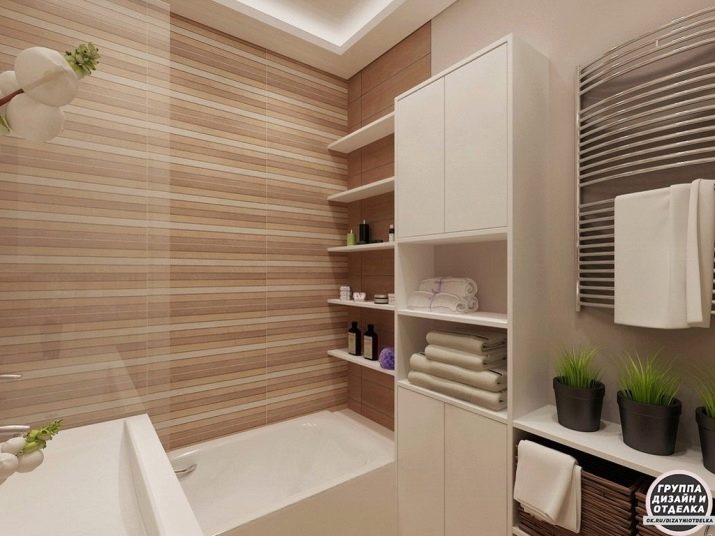
- High tech. Depending on the chosen accents in this style, both steel and brass models of heated towel rails can look good.
In this case, the presence of non-standard shapes and sizes that this style welcomes is limited due to the design features of the heating elements.


Manufacturers
Today's market of heated towel rails offers a huge number of different models that differ in different operating principles, as well as power and pressure indicators. Inexperienced consumers may find it difficult to distinguish between high-quality and low-quality brands, therefore, below is a list of the most popular manufacturers who produce the highest quality and affordable heating appliances for bathrooms.
- "Sunergea." Sunerji products have been on the market for about 20 years - they have been manufacturing electronic towel dryers in innovative and standard designs.
This brand was one of the first to use stainless steel for the production of radiators and heating units.
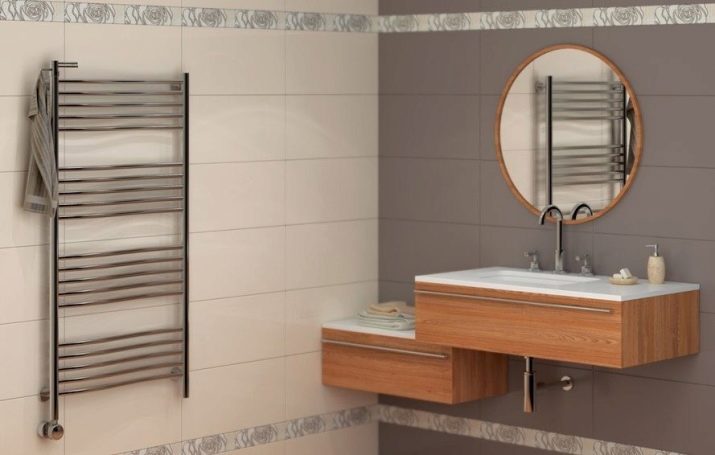
- "Nika". This is one of the most famous Russian manufacturers, which creates high-quality and affordable stainless steel heated towel rails.
A key feature of the brand is the release of models with additional elements in the form of shelves and towel hooks.
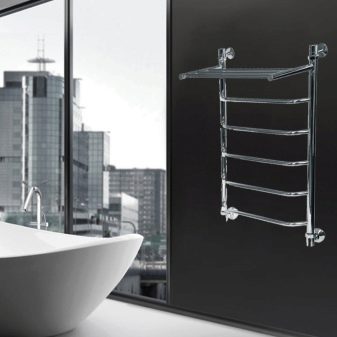
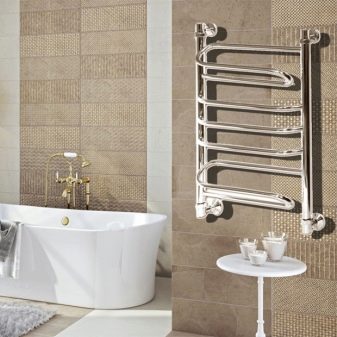
- Zehnder. A popular and respected German company that produces heated towel rails of absolutely any shape and size. The company is proud of the possibility of applying absolutely any color coating to its units. Most often, powder enamel and chromium plating are chosen for coatings.


- Argo. Another Russian manufacturer that produces classic and designer stainless steel heated towel rails with special polymer protection inside the pipes.
The products of this brand are distinguished by an increased price, but also a longer service life.
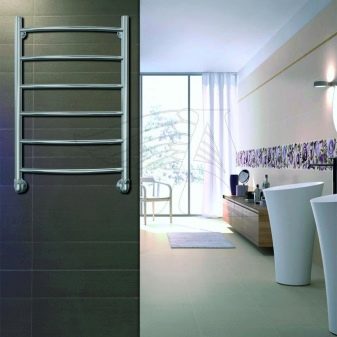
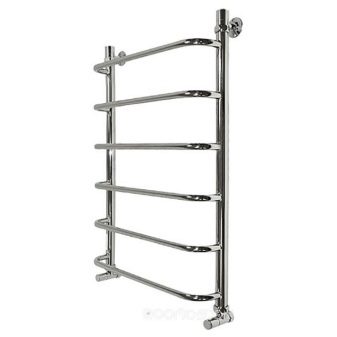
- Leroy. The company produces heating systems and high-quality radiators made of stainless steel. In addition, the products of this brand are characterized by an affordable price range.

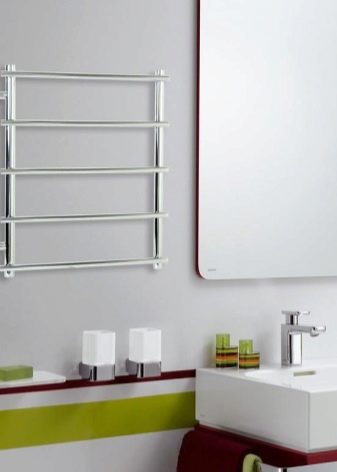
How to choose?
In order for the heated towel rail to serve you for a long time and ensure a high-quality level of drying, you should correctly approach its choice.
Key factors for choosing a heated towel rail.
- Principle of operation. As already mentioned, there are 3 types of dryers - water, electric and combined. Water and electric should be purchased for those who live in regions without interruptions in heating and with a stable supply of electricity. In other cases, combined units that can act as a dryer in the absence of electricity or hot water should save the situation.
From the point of view of economy, it is water options that are the most budgetary, however, regarding installation, of course, the electric ones are simpler.
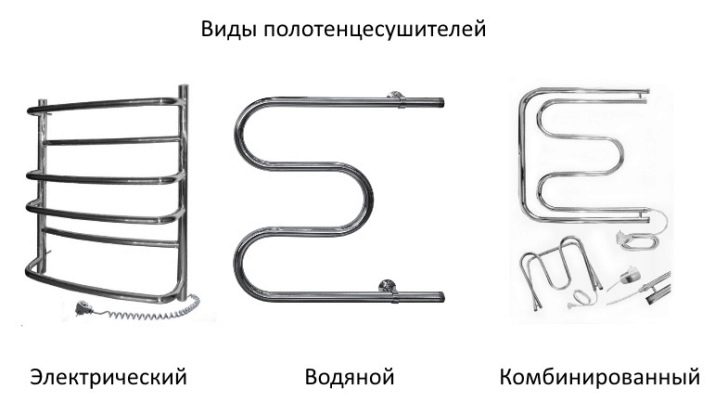
- The material of manufacture. You should immediately determine what material you want to buy a heated towel rail from. The most versatile and durable material is stainless steel, but copper or brass models are most suitable for decorating a bathroom in a specific style.
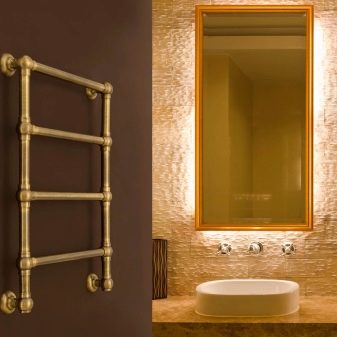

- Related documentation and equipment. Do not forget to check whether all the elements declared in the description of the device are present in the kit. In addition, pay attention to the documents that must be attached to any branded product: technical passport, hygiene certificate, quality certificate from the manufacturer, warranty card, user manual in the form of installation and operation instructions.

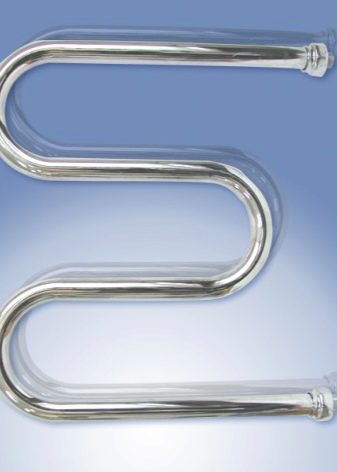
- Power (applies to electric models) and maximum pressure (for water units). The power of the device affects the drying speed of linen and towels. We should not forget that power also raises the temperature level in the room, and therefore, in bathrooms where there is a warm floor, you should not buy heated towel rails of high power. The internal pressure in the water units is responsible for the safe use of the device and the line with a certain pressure.
It is believed that the intake unit must have a pressure of at least 6 atmospheres.
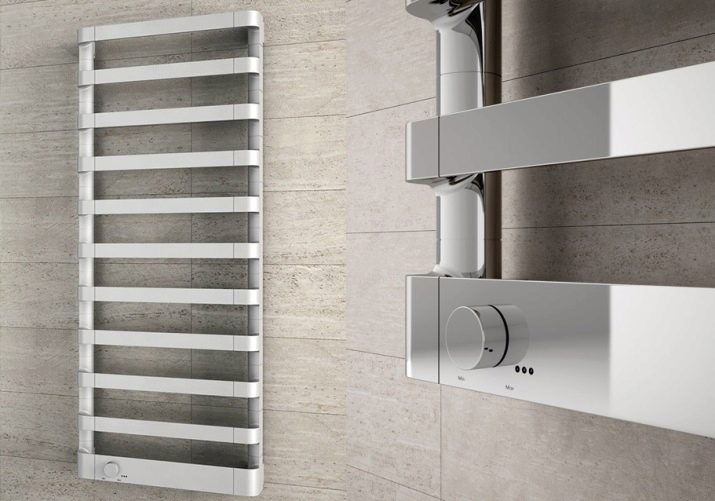
- Connection method. There are heated towel rails with lower, upper, diagonal and side connections. Units with a lower or diagonal connection are considered to be the most effective, the upper connection is considered to be the most ineffective, but the side option will allow you to mount the dryer anywhere in the bathroom.
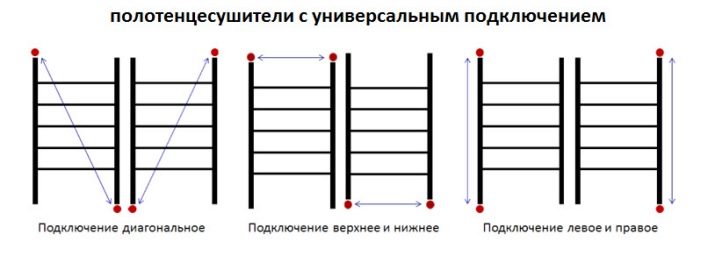
- Functionality. For drying things in the room, ordinary water heated towel rails will also work, but if you want to buy a multifunctional device with timers and a thermostat, it is best to choose combined or electric options.
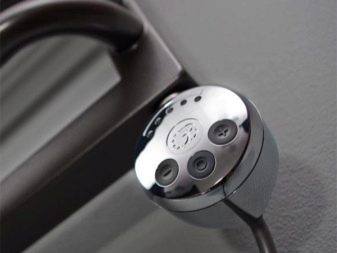
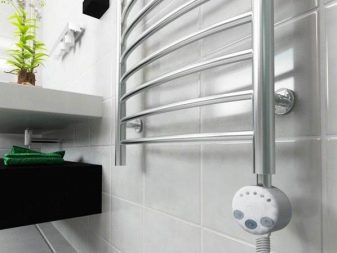
Examples in the interior
- Classic. Pay attention to the silver and gold tones, as well as the solidity of such units.
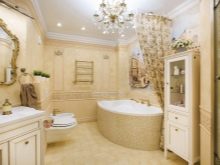
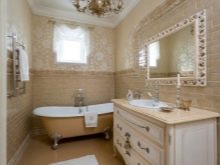
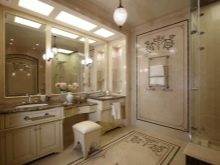
- Minimalism. There are no creative design colors and solutions in this style - most often these are steel, chrome or matte heated towel rails of standard shapes. Take a look at how interesting the “ladder” type units look in this style.
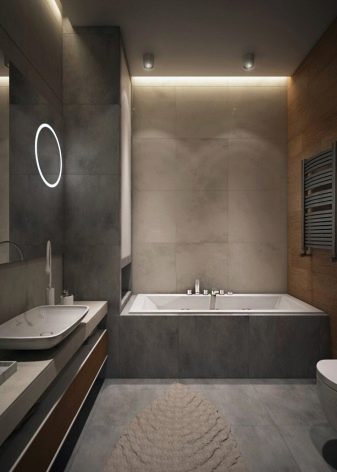

- Retro. In this style solution, both classic steel dryers and fancy copper units with slightly convex shapes can look spectacular.
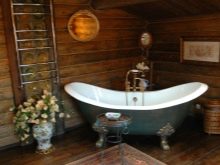
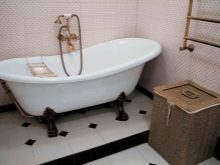
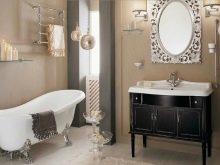
See how to choose a heated towel rail in the next video.
